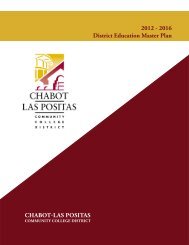City College of San Francisco - California Competes
City College of San Francisco - California Competes
City College of San Francisco - California Competes
You also want an ePaper? Increase the reach of your titles
YUMPU automatically turns print PDFs into web optimized ePapers that Google loves.
STANDARD II.A<br />
some departments (e.g., Journalism, Architecture,<br />
and Automotive Technology) have incorporated<br />
facilitation techniques such as a SWOT 10 analysis<br />
or the DACUM process while undergoing<br />
Program Review to evaluate the effectiveness<br />
<strong>of</strong> their instructional programs.<br />
At this time, assessment <strong>of</strong> student learning outcomes<br />
within the Program Review process occurs<br />
through the review <strong>of</strong> several indicators. These<br />
indicators include: completion rates for all<br />
instructional programs, the number <strong>of</strong> students<br />
that transition from basic skills to degree applicable<br />
coursework, rates <strong>of</strong> transfer to four-year<br />
institutions, the number <strong>of</strong> associate degrees,<br />
awards <strong>of</strong> achievement, and certificates granted,<br />
the number <strong>of</strong> students acquiring external licensure,<br />
and the number <strong>of</strong> students who complete<br />
internships.<br />
Based on the 2000 Accreditation Self Study<br />
Report, the visiting team stated, “given the<br />
importance <strong>of</strong> the program review system in<br />
assessing institutional effectiveness and that the<br />
findings <strong>of</strong> program reviews are an important<br />
consideration in the budget allocation process,<br />
the team recommends the <strong>College</strong> ensure the<br />
institutionalization <strong>of</strong> their program review<br />
process by requiring that all units complete their<br />
program reviews in a timely and thorough fashion.”<br />
[Ref. 18] At this time, approximately 70<br />
percent <strong>of</strong> the program reviews due from instructional<br />
units, with deadlines ranging from 2000<br />
to 2003, have been completed. In contrast, the<br />
completion rate for the non-instructional departments<br />
during the same timeframe is 40 percent.<br />
[Ref. 19]<br />
II.A.2.f. The institution engages in ongoing, systematic<br />
evaluation and integrated planning to<br />
assure currency and measure achievement <strong>of</strong> its<br />
stated student learning outcomes for courses,<br />
certificates, programs including general and<br />
vocational education and degrees. The institution<br />
systematically strives to improve those<br />
outcomes and makes the results available to<br />
appropriate constituencies.<br />
The institution engages in planning at many levels<br />
which is manifested through a variety <strong>of</strong><br />
documents. Overarching planning documents<br />
include the Strategic Plan, the Management Plan<br />
and the Educational Master Plan. Planning also<br />
occurs on an annual basis and includes the<br />
Annual Plan and the Mid-Year and End-<strong>of</strong>-Year<br />
Assessment Reports. The <strong>College</strong> Performance<br />
Indicators Report is an annual publication and<br />
serves to provide a set <strong>of</strong> performance indicators<br />
aligned with the eight priorities <strong>of</strong> the Strategic<br />
Plan. This report is published and made available<br />
to the residents <strong>of</strong> <strong>San</strong> <strong>Francisco</strong>.<br />
The systematic review <strong>of</strong> instructional programs<br />
primarily occurs through the Program Review<br />
process and is supplemented by the <strong>College</strong><br />
Curriculum Committee. Program Review is<br />
designed to provide faculty the opportunity to<br />
engage in a self study that encompasses several<br />
aspects <strong>of</strong> their program including a review <strong>of</strong><br />
student learning outcomes and program<br />
improvement.<br />
Another process used to evaluate instructional<br />
programs is the Carl D. Perkins Vocational and<br />
Technical Education Act (VTEA) <strong>of</strong> 1998. For<br />
many years the institution has used a formal and<br />
systematic method for the allocation <strong>of</strong> VTEA<br />
funds. The Office <strong>of</strong> Vocational Education<br />
administers this evaluation process that begins<br />
with an annual election <strong>of</strong> an allocation committee.<br />
To access VTEA funds, a vocational<br />
department must submit a proposal. A VTEA<br />
Development Team must be established within<br />
the department and receive training from the<br />
VTEA Coordinator regarding the effective development<br />
<strong>of</strong> proposals that fulfill departmental<br />
needs and the criteria established under Federal<br />
legislation. These proposals must demonstrate<br />
10 SWOT (Strengths, Weaknesses, Opportunities and Threats) is a device used to bring to light opportunities and threats and for<br />
ongoing assessment <strong>of</strong> strengths and weaknesses within an organization or program. A SWOT exercise usually lasts between<br />
20-60 minutes and involves group participation.<br />
120 CITY COLLEGE OF SAN FRANCISCO







